Report: Strategic Management Practices for Non-Profit Organizations
VerifiedAdded on 2020/04/15
|17
|3816
|101
Report
AI Summary
This report delves into the crucial role of strategic management within non-profit organizations. It examines the implementation of major objectives, highlighting the significance of effective leadership, board governance, and community engagement. The report employs descriptive qualitative methods to analyze the challenges faced by non-profit organizations and proposes strategic solutions. It covers key aspects such as internal leadership, identifying strategic issues, and the importance of staff and board collaboration. The literature review synthesizes various sources to illustrate how strategic management influences the success of non-profit entities. The report emphasizes the significance of the board's role in mission advocacy, financial health, and fostering relationships, alongside the need for internal leadership cultivation. The report also provides an overview of strategic management models and theories that can be used to address challenges and achieve organizational goals, emphasizing the importance of a psychologically safe environment where diverse viewpoints are considered to foster constructive conflict resolution and effective planning.

Running head: STRATEGIC MANAGEMENT IN NON-PROFIT ORGANISATION
Strategic Management in Non-Profit Organisation
Name of the student
Name of the University
Author note
Strategic Management in Non-Profit Organisation
Name of the student
Name of the University
Author note
Paraphrase This Document
Need a fresh take? Get an instant paraphrase of this document with our AI Paraphraser
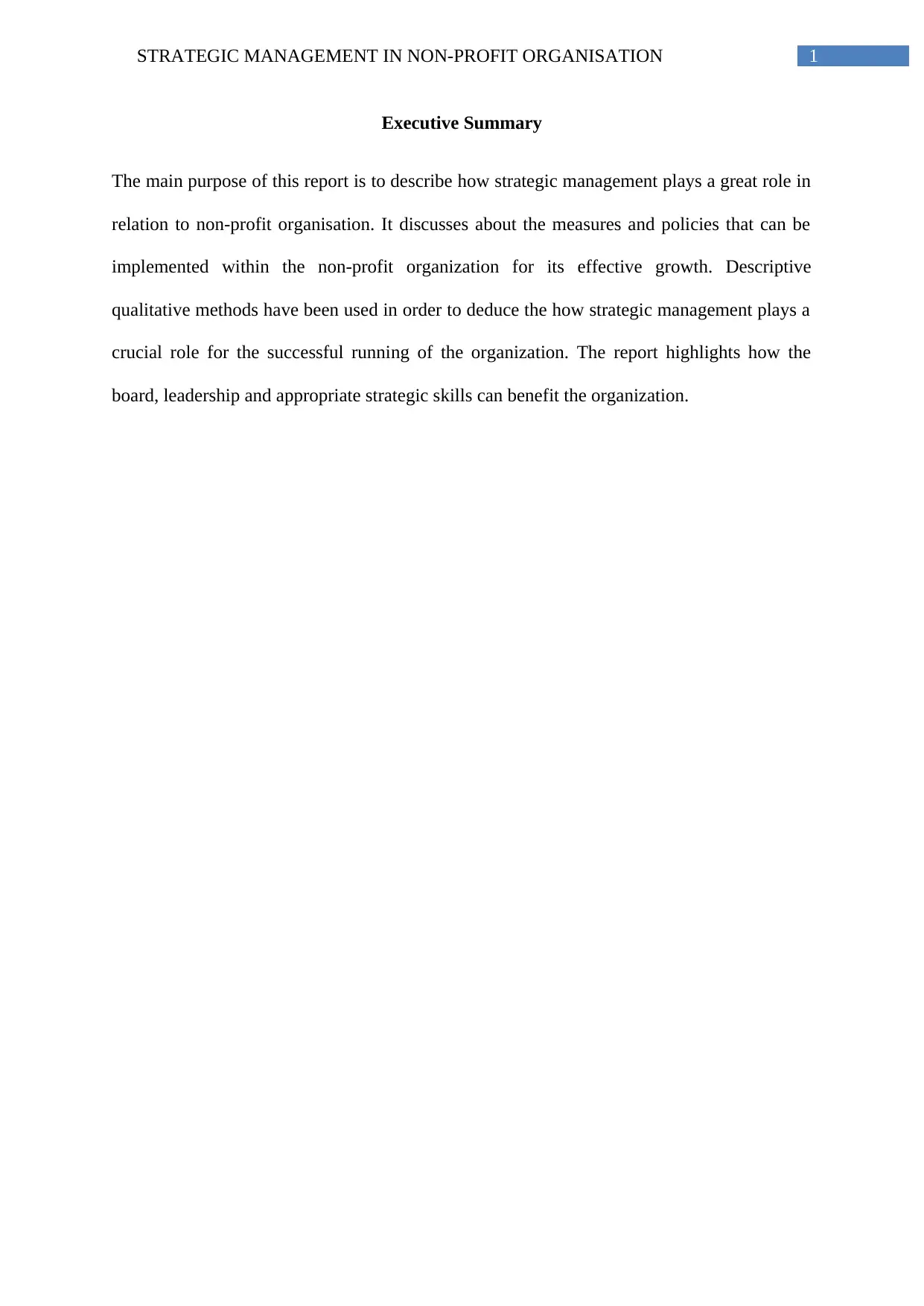
1STRATEGIC MANAGEMENT IN NON-PROFIT ORGANISATION
Executive Summary
The main purpose of this report is to describe how strategic management plays a great role in
relation to non-profit organisation. It discusses about the measures and policies that can be
implemented within the non-profit organization for its effective growth. Descriptive
qualitative methods have been used in order to deduce the how strategic management plays a
crucial role for the successful running of the organization. The report highlights how the
board, leadership and appropriate strategic skills can benefit the organization.
Executive Summary
The main purpose of this report is to describe how strategic management plays a great role in
relation to non-profit organisation. It discusses about the measures and policies that can be
implemented within the non-profit organization for its effective growth. Descriptive
qualitative methods have been used in order to deduce the how strategic management plays a
crucial role for the successful running of the organization. The report highlights how the
board, leadership and appropriate strategic skills can benefit the organization.
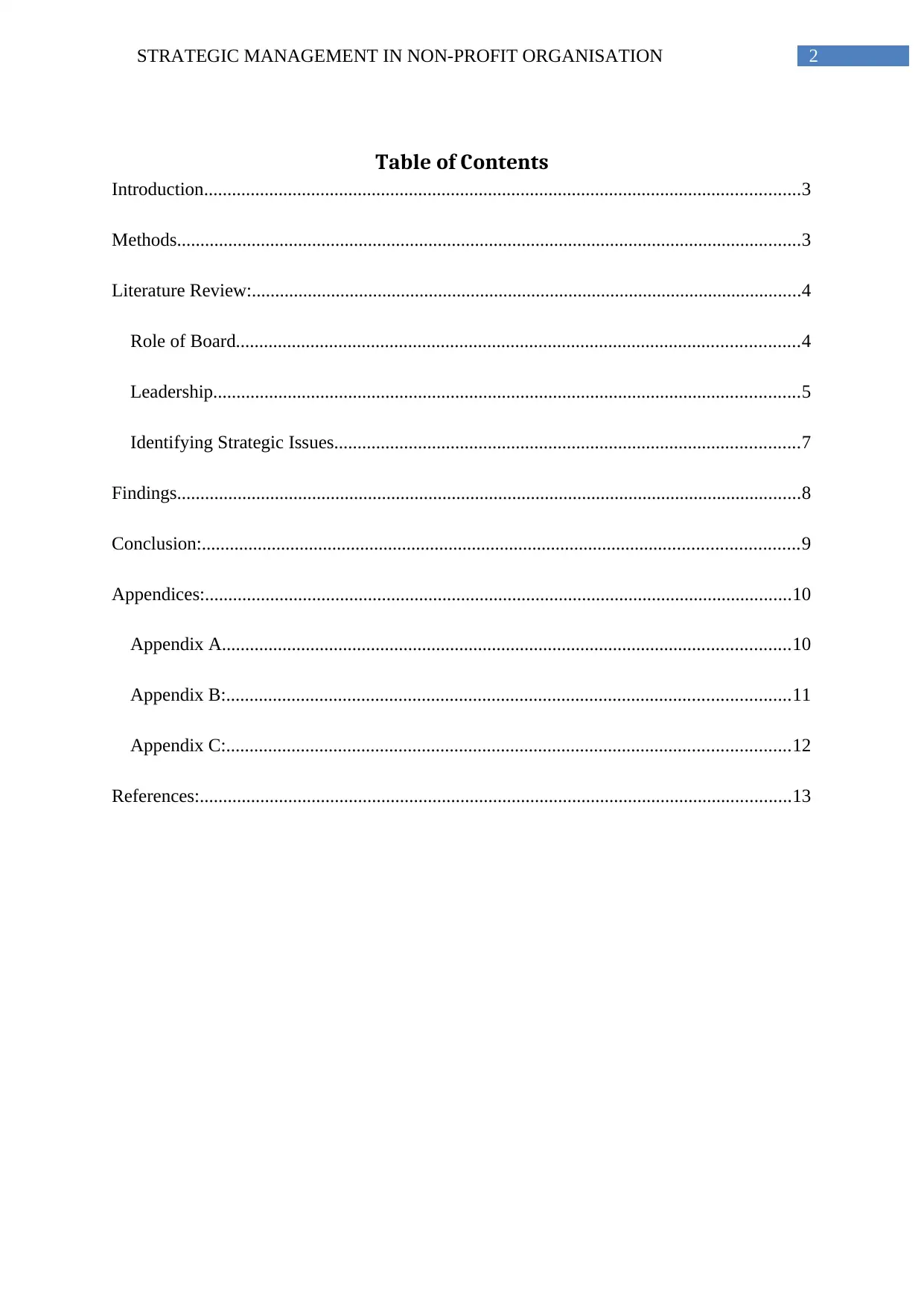
2STRATEGIC MANAGEMENT IN NON-PROFIT ORGANISATION
Table of Contents
Introduction................................................................................................................................3
Methods......................................................................................................................................3
Literature Review:......................................................................................................................4
Role of Board.........................................................................................................................4
Leadership..............................................................................................................................5
Identifying Strategic Issues....................................................................................................7
Findings......................................................................................................................................8
Conclusion:................................................................................................................................9
Appendices:..............................................................................................................................10
Appendix A..........................................................................................................................10
Appendix B:.........................................................................................................................11
Appendix C:.........................................................................................................................12
References:...............................................................................................................................13
Table of Contents
Introduction................................................................................................................................3
Methods......................................................................................................................................3
Literature Review:......................................................................................................................4
Role of Board.........................................................................................................................4
Leadership..............................................................................................................................5
Identifying Strategic Issues....................................................................................................7
Findings......................................................................................................................................8
Conclusion:................................................................................................................................9
Appendices:..............................................................................................................................10
Appendix A..........................................................................................................................10
Appendix B:.........................................................................................................................11
Appendix C:.........................................................................................................................12
References:...............................................................................................................................13
⊘ This is a preview!⊘
Do you want full access?
Subscribe today to unlock all pages.

Trusted by 1+ million students worldwide
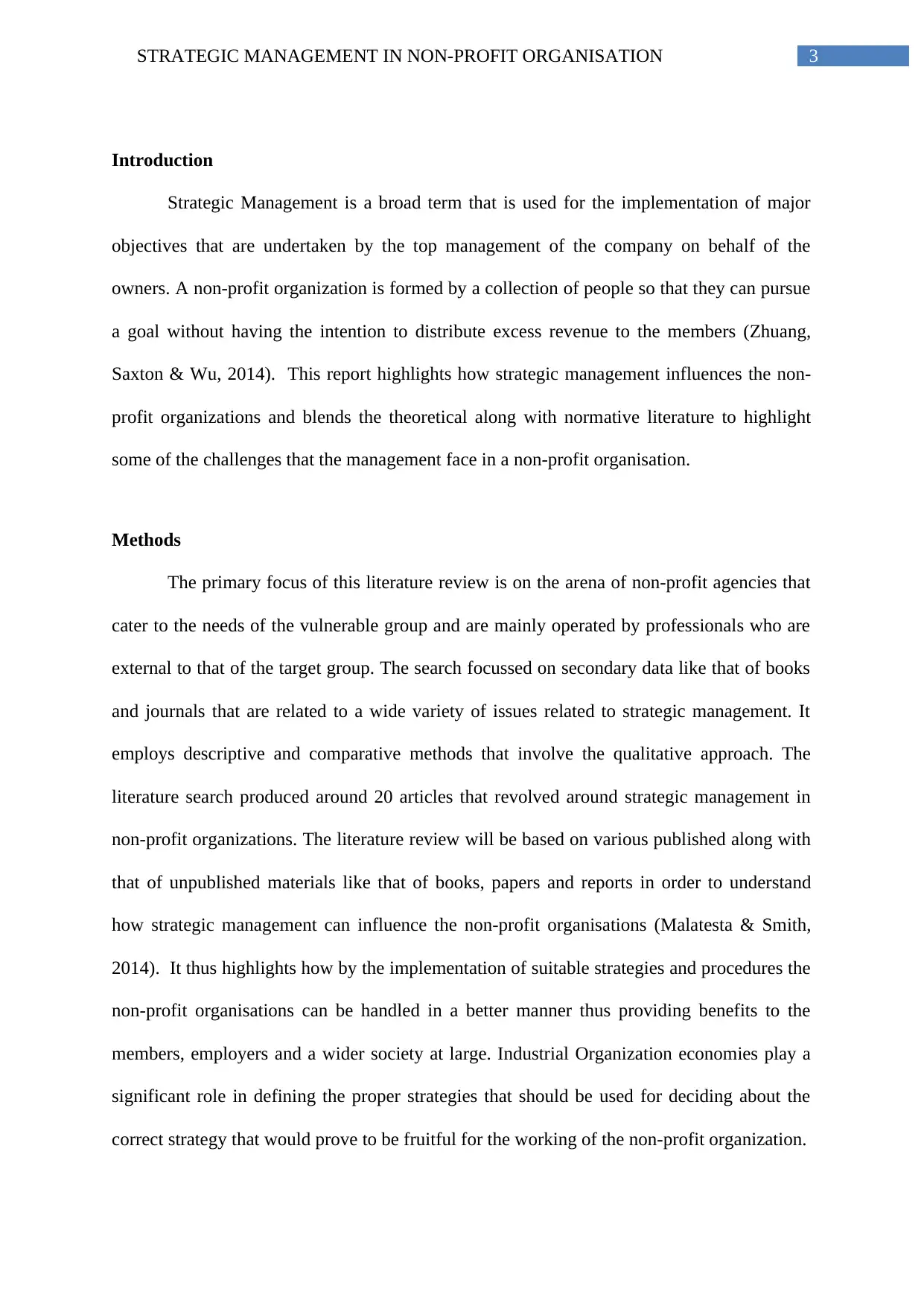
3STRATEGIC MANAGEMENT IN NON-PROFIT ORGANISATION
Introduction
Strategic Management is a broad term that is used for the implementation of major
objectives that are undertaken by the top management of the company on behalf of the
owners. A non-profit organization is formed by a collection of people so that they can pursue
a goal without having the intention to distribute excess revenue to the members (Zhuang,
Saxton & Wu, 2014). This report highlights how strategic management influences the non-
profit organizations and blends the theoretical along with normative literature to highlight
some of the challenges that the management face in a non-profit organisation.
Methods
The primary focus of this literature review is on the arena of non-profit agencies that
cater to the needs of the vulnerable group and are mainly operated by professionals who are
external to that of the target group. The search focussed on secondary data like that of books
and journals that are related to a wide variety of issues related to strategic management. It
employs descriptive and comparative methods that involve the qualitative approach. The
literature search produced around 20 articles that revolved around strategic management in
non-profit organizations. The literature review will be based on various published along with
that of unpublished materials like that of books, papers and reports in order to understand
how strategic management can influence the non-profit organisations (Malatesta & Smith,
2014). It thus highlights how by the implementation of suitable strategies and procedures the
non-profit organisations can be handled in a better manner thus providing benefits to the
members, employers and a wider society at large. Industrial Organization economies play a
significant role in defining the proper strategies that should be used for deciding about the
correct strategy that would prove to be fruitful for the working of the non-profit organization.
Introduction
Strategic Management is a broad term that is used for the implementation of major
objectives that are undertaken by the top management of the company on behalf of the
owners. A non-profit organization is formed by a collection of people so that they can pursue
a goal without having the intention to distribute excess revenue to the members (Zhuang,
Saxton & Wu, 2014). This report highlights how strategic management influences the non-
profit organizations and blends the theoretical along with normative literature to highlight
some of the challenges that the management face in a non-profit organisation.
Methods
The primary focus of this literature review is on the arena of non-profit agencies that
cater to the needs of the vulnerable group and are mainly operated by professionals who are
external to that of the target group. The search focussed on secondary data like that of books
and journals that are related to a wide variety of issues related to strategic management. It
employs descriptive and comparative methods that involve the qualitative approach. The
literature search produced around 20 articles that revolved around strategic management in
non-profit organizations. The literature review will be based on various published along with
that of unpublished materials like that of books, papers and reports in order to understand
how strategic management can influence the non-profit organisations (Malatesta & Smith,
2014). It thus highlights how by the implementation of suitable strategies and procedures the
non-profit organisations can be handled in a better manner thus providing benefits to the
members, employers and a wider society at large. Industrial Organization economies play a
significant role in defining the proper strategies that should be used for deciding about the
correct strategy that would prove to be fruitful for the working of the non-profit organization.
Paraphrase This Document
Need a fresh take? Get an instant paraphrase of this document with our AI Paraphraser
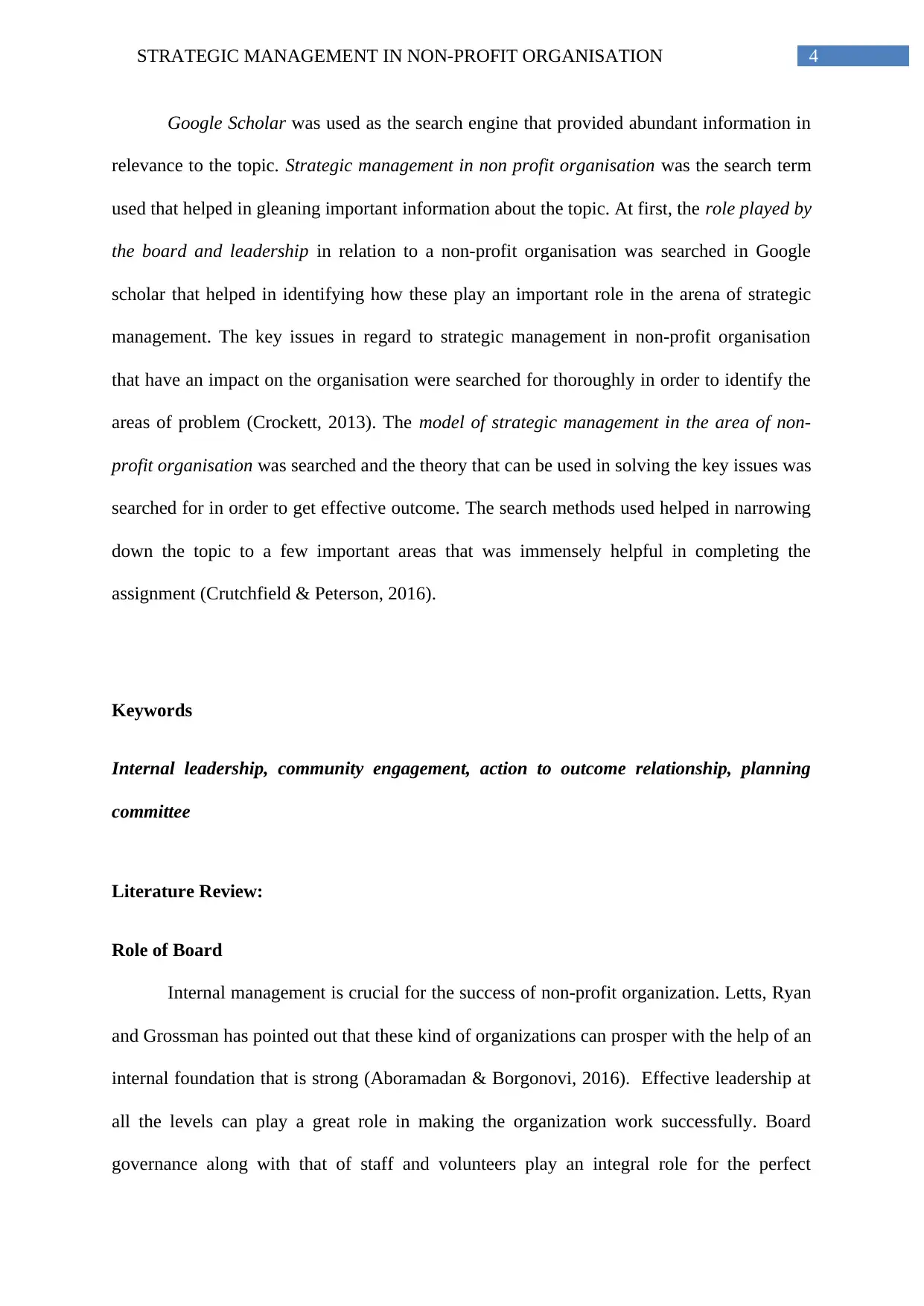
4STRATEGIC MANAGEMENT IN NON-PROFIT ORGANISATION
Google Scholar was used as the search engine that provided abundant information in
relevance to the topic. Strategic management in non profit organisation was the search term
used that helped in gleaning important information about the topic. At first, the role played by
the board and leadership in relation to a non-profit organisation was searched in Google
scholar that helped in identifying how these play an important role in the arena of strategic
management. The key issues in regard to strategic management in non-profit organisation
that have an impact on the organisation were searched for thoroughly in order to identify the
areas of problem (Crockett, 2013). The model of strategic management in the area of non-
profit organisation was searched and the theory that can be used in solving the key issues was
searched for in order to get effective outcome. The search methods used helped in narrowing
down the topic to a few important areas that was immensely helpful in completing the
assignment (Crutchfield & Peterson, 2016).
Keywords
Internal leadership, community engagement, action to outcome relationship, planning
committee
Literature Review:
Role of Board
Internal management is crucial for the success of non-profit organization. Letts, Ryan
and Grossman has pointed out that these kind of organizations can prosper with the help of an
internal foundation that is strong (Aboramadan & Borgonovi, 2016). Effective leadership at
all the levels can play a great role in making the organization work successfully. Board
governance along with that of staff and volunteers play an integral role for the perfect
Google Scholar was used as the search engine that provided abundant information in
relevance to the topic. Strategic management in non profit organisation was the search term
used that helped in gleaning important information about the topic. At first, the role played by
the board and leadership in relation to a non-profit organisation was searched in Google
scholar that helped in identifying how these play an important role in the arena of strategic
management. The key issues in regard to strategic management in non-profit organisation
that have an impact on the organisation were searched for thoroughly in order to identify the
areas of problem (Crockett, 2013). The model of strategic management in the area of non-
profit organisation was searched and the theory that can be used in solving the key issues was
searched for in order to get effective outcome. The search methods used helped in narrowing
down the topic to a few important areas that was immensely helpful in completing the
assignment (Crutchfield & Peterson, 2016).
Keywords
Internal leadership, community engagement, action to outcome relationship, planning
committee
Literature Review:
Role of Board
Internal management is crucial for the success of non-profit organization. Letts, Ryan
and Grossman has pointed out that these kind of organizations can prosper with the help of an
internal foundation that is strong (Aboramadan & Borgonovi, 2016). Effective leadership at
all the levels can play a great role in making the organization work successfully. Board
governance along with that of staff and volunteers play an integral role for the perfect
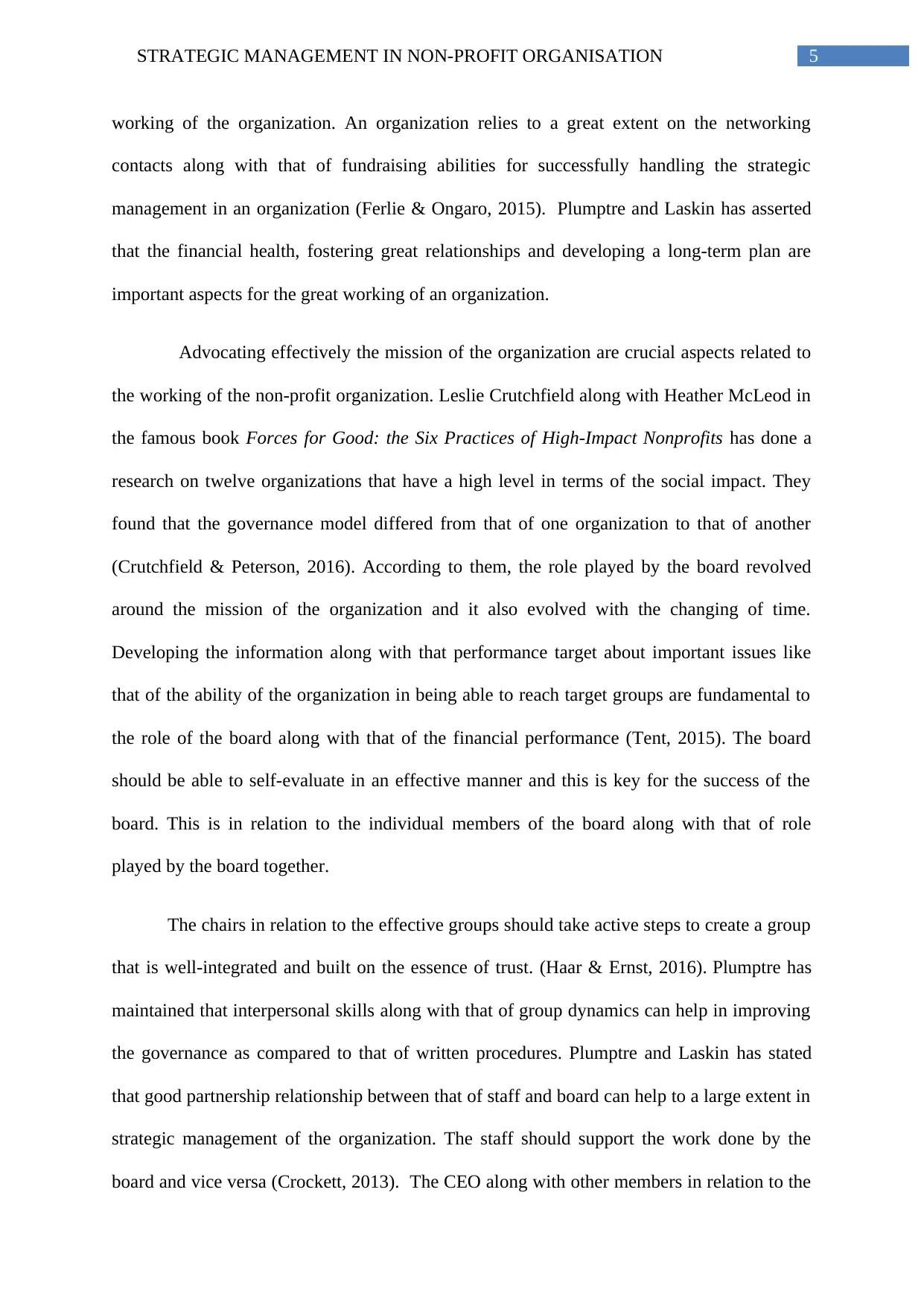
5STRATEGIC MANAGEMENT IN NON-PROFIT ORGANISATION
working of the organization. An organization relies to a great extent on the networking
contacts along with that of fundraising abilities for successfully handling the strategic
management in an organization (Ferlie & Ongaro, 2015). Plumptre and Laskin has asserted
that the financial health, fostering great relationships and developing a long-term plan are
important aspects for the great working of an organization.
Advocating effectively the mission of the organization are crucial aspects related to
the working of the non-profit organization. Leslie Crutchfield along with Heather McLeod in
the famous book Forces for Good: the Six Practices of High-Impact Nonprofits has done a
research on twelve organizations that have a high level in terms of the social impact. They
found that the governance model differed from that of one organization to that of another
(Crutchfield & Peterson, 2016). According to them, the role played by the board revolved
around the mission of the organization and it also evolved with the changing of time.
Developing the information along with that performance target about important issues like
that of the ability of the organization in being able to reach target groups are fundamental to
the role of the board along with that of the financial performance (Tent, 2015). The board
should be able to self-evaluate in an effective manner and this is key for the success of the
board. This is in relation to the individual members of the board along with that of role
played by the board together.
The chairs in relation to the effective groups should take active steps to create a group
that is well-integrated and built on the essence of trust. (Haar & Ernst, 2016). Plumptre has
maintained that interpersonal skills along with that of group dynamics can help in improving
the governance as compared to that of written procedures. Plumptre and Laskin has stated
that good partnership relationship between that of staff and board can help to a large extent in
strategic management of the organization. The staff should support the work done by the
board and vice versa (Crockett, 2013). The CEO along with other members in relation to the
working of the organization. An organization relies to a great extent on the networking
contacts along with that of fundraising abilities for successfully handling the strategic
management in an organization (Ferlie & Ongaro, 2015). Plumptre and Laskin has asserted
that the financial health, fostering great relationships and developing a long-term plan are
important aspects for the great working of an organization.
Advocating effectively the mission of the organization are crucial aspects related to
the working of the non-profit organization. Leslie Crutchfield along with Heather McLeod in
the famous book Forces for Good: the Six Practices of High-Impact Nonprofits has done a
research on twelve organizations that have a high level in terms of the social impact. They
found that the governance model differed from that of one organization to that of another
(Crutchfield & Peterson, 2016). According to them, the role played by the board revolved
around the mission of the organization and it also evolved with the changing of time.
Developing the information along with that performance target about important issues like
that of the ability of the organization in being able to reach target groups are fundamental to
the role of the board along with that of the financial performance (Tent, 2015). The board
should be able to self-evaluate in an effective manner and this is key for the success of the
board. This is in relation to the individual members of the board along with that of role
played by the board together.
The chairs in relation to the effective groups should take active steps to create a group
that is well-integrated and built on the essence of trust. (Haar & Ernst, 2016). Plumptre has
maintained that interpersonal skills along with that of group dynamics can help in improving
the governance as compared to that of written procedures. Plumptre and Laskin has stated
that good partnership relationship between that of staff and board can help to a large extent in
strategic management of the organization. The staff should support the work done by the
board and vice versa (Crockett, 2013). The CEO along with other members in relation to the
⊘ This is a preview!⊘
Do you want full access?
Subscribe today to unlock all pages.

Trusted by 1+ million students worldwide
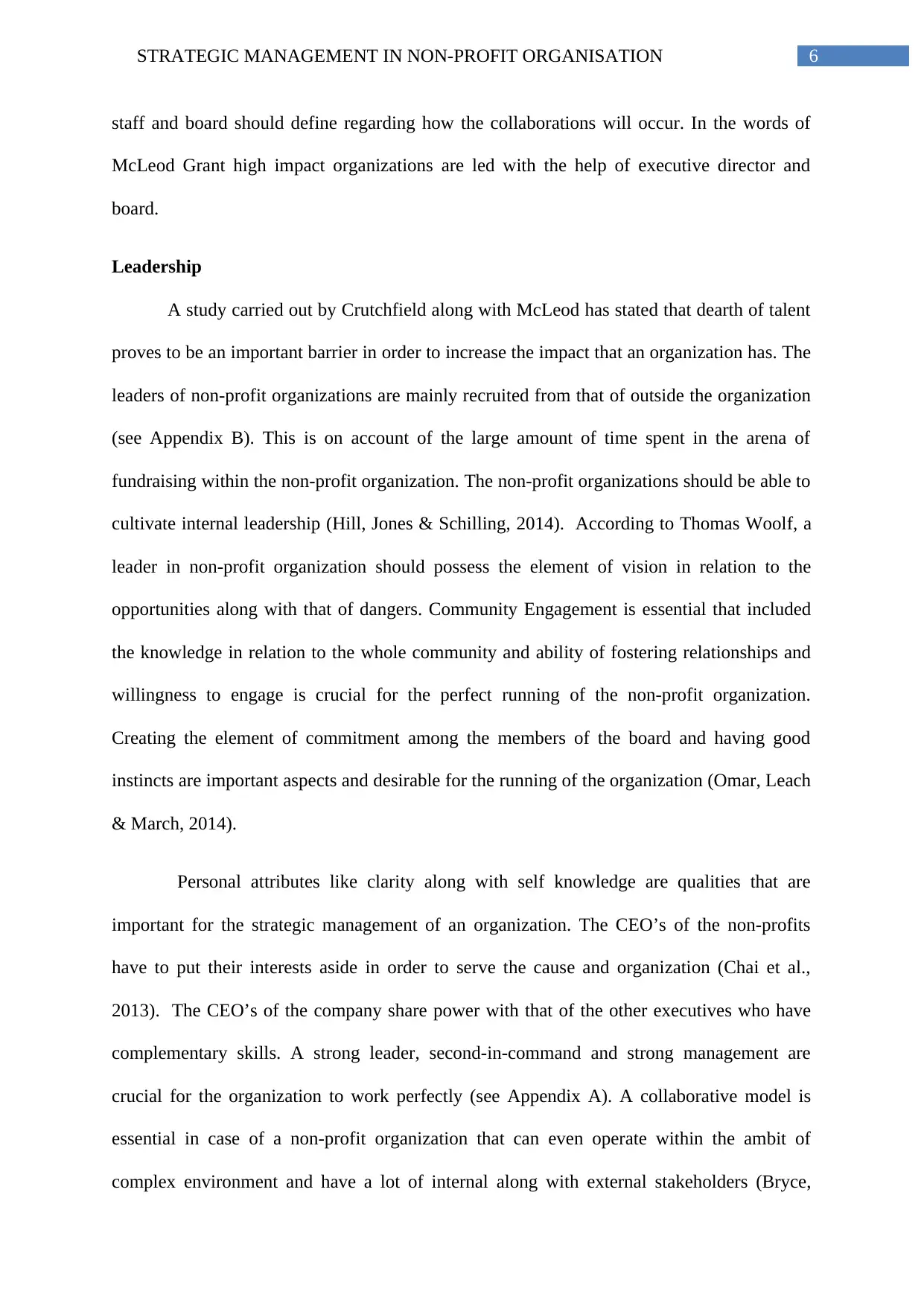
6STRATEGIC MANAGEMENT IN NON-PROFIT ORGANISATION
staff and board should define regarding how the collaborations will occur. In the words of
McLeod Grant high impact organizations are led with the help of executive director and
board.
Leadership
A study carried out by Crutchfield along with McLeod has stated that dearth of talent
proves to be an important barrier in order to increase the impact that an organization has. The
leaders of non-profit organizations are mainly recruited from that of outside the organization
(see Appendix B). This is on account of the large amount of time spent in the arena of
fundraising within the non-profit organization. The non-profit organizations should be able to
cultivate internal leadership (Hill, Jones & Schilling, 2014). According to Thomas Woolf, a
leader in non-profit organization should possess the element of vision in relation to the
opportunities along with that of dangers. Community Engagement is essential that included
the knowledge in relation to the whole community and ability of fostering relationships and
willingness to engage is crucial for the perfect running of the non-profit organization.
Creating the element of commitment among the members of the board and having good
instincts are important aspects and desirable for the running of the organization (Omar, Leach
& March, 2014).
Personal attributes like clarity along with self knowledge are qualities that are
important for the strategic management of an organization. The CEO’s of the non-profits
have to put their interests aside in order to serve the cause and organization (Chai et al.,
2013). The CEO’s of the company share power with that of the other executives who have
complementary skills. A strong leader, second-in-command and strong management are
crucial for the organization to work perfectly (see Appendix A). A collaborative model is
essential in case of a non-profit organization that can even operate within the ambit of
complex environment and have a lot of internal along with external stakeholders (Bryce,
staff and board should define regarding how the collaborations will occur. In the words of
McLeod Grant high impact organizations are led with the help of executive director and
board.
Leadership
A study carried out by Crutchfield along with McLeod has stated that dearth of talent
proves to be an important barrier in order to increase the impact that an organization has. The
leaders of non-profit organizations are mainly recruited from that of outside the organization
(see Appendix B). This is on account of the large amount of time spent in the arena of
fundraising within the non-profit organization. The non-profit organizations should be able to
cultivate internal leadership (Hill, Jones & Schilling, 2014). According to Thomas Woolf, a
leader in non-profit organization should possess the element of vision in relation to the
opportunities along with that of dangers. Community Engagement is essential that included
the knowledge in relation to the whole community and ability of fostering relationships and
willingness to engage is crucial for the perfect running of the non-profit organization.
Creating the element of commitment among the members of the board and having good
instincts are important aspects and desirable for the running of the organization (Omar, Leach
& March, 2014).
Personal attributes like clarity along with self knowledge are qualities that are
important for the strategic management of an organization. The CEO’s of the non-profits
have to put their interests aside in order to serve the cause and organization (Chai et al.,
2013). The CEO’s of the company share power with that of the other executives who have
complementary skills. A strong leader, second-in-command and strong management are
crucial for the organization to work perfectly (see Appendix A). A collaborative model is
essential in case of a non-profit organization that can even operate within the ambit of
complex environment and have a lot of internal along with external stakeholders (Bryce,
Paraphrase This Document
Need a fresh take? Get an instant paraphrase of this document with our AI Paraphraser
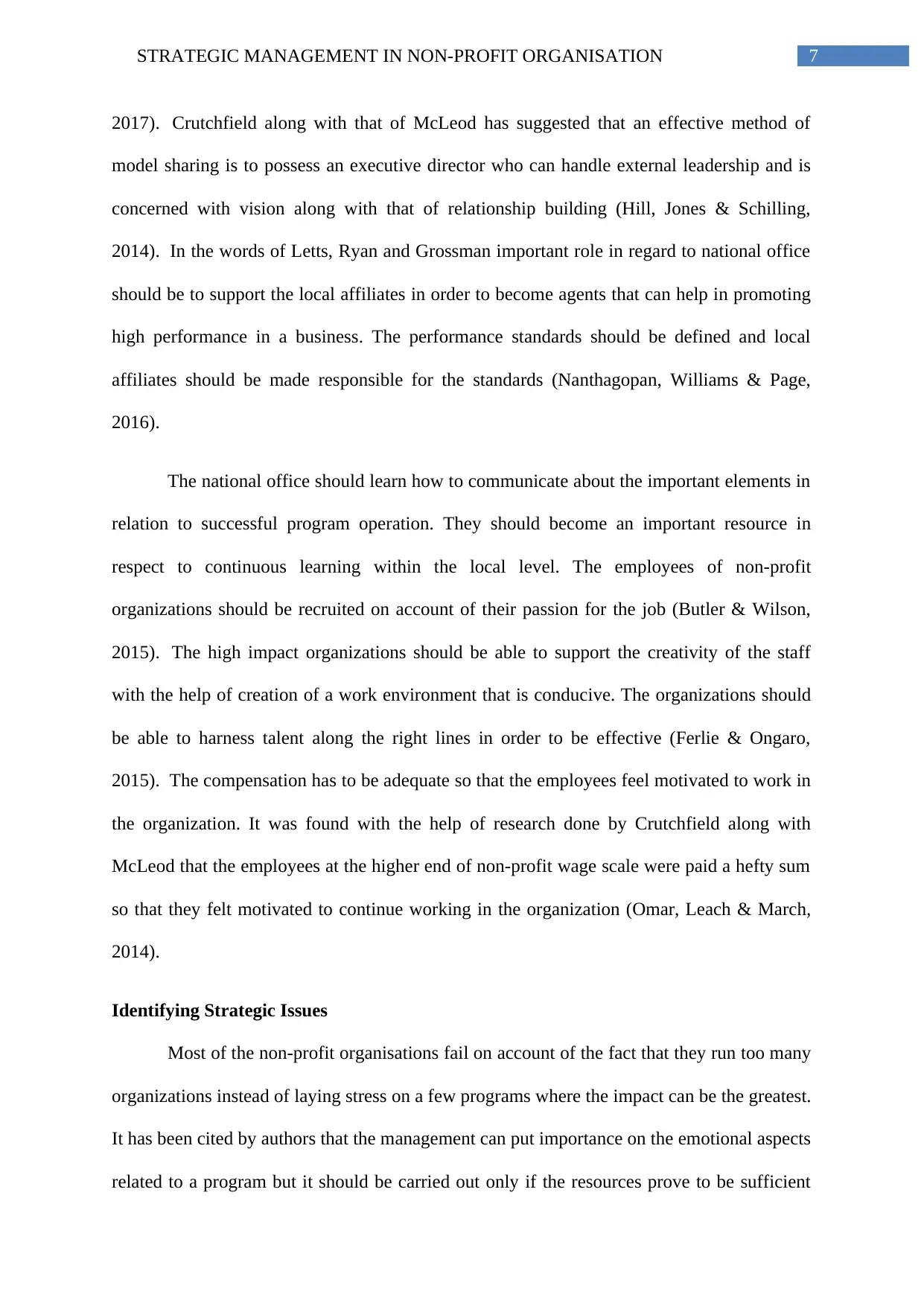
7STRATEGIC MANAGEMENT IN NON-PROFIT ORGANISATION
2017). Crutchfield along with that of McLeod has suggested that an effective method of
model sharing is to possess an executive director who can handle external leadership and is
concerned with vision along with that of relationship building (Hill, Jones & Schilling,
2014). In the words of Letts, Ryan and Grossman important role in regard to national office
should be to support the local affiliates in order to become agents that can help in promoting
high performance in a business. The performance standards should be defined and local
affiliates should be made responsible for the standards (Nanthagopan, Williams & Page,
2016).
The national office should learn how to communicate about the important elements in
relation to successful program operation. They should become an important resource in
respect to continuous learning within the local level. The employees of non-profit
organizations should be recruited on account of their passion for the job (Butler & Wilson,
2015). The high impact organizations should be able to support the creativity of the staff
with the help of creation of a work environment that is conducive. The organizations should
be able to harness talent along the right lines in order to be effective (Ferlie & Ongaro,
2015). The compensation has to be adequate so that the employees feel motivated to work in
the organization. It was found with the help of research done by Crutchfield along with
McLeod that the employees at the higher end of non-profit wage scale were paid a hefty sum
so that they felt motivated to continue working in the organization (Omar, Leach & March,
2014).
Identifying Strategic Issues
Most of the non-profit organisations fail on account of the fact that they run too many
organizations instead of laying stress on a few programs where the impact can be the greatest.
It has been cited by authors that the management can put importance on the emotional aspects
related to a program but it should be carried out only if the resources prove to be sufficient
2017). Crutchfield along with that of McLeod has suggested that an effective method of
model sharing is to possess an executive director who can handle external leadership and is
concerned with vision along with that of relationship building (Hill, Jones & Schilling,
2014). In the words of Letts, Ryan and Grossman important role in regard to national office
should be to support the local affiliates in order to become agents that can help in promoting
high performance in a business. The performance standards should be defined and local
affiliates should be made responsible for the standards (Nanthagopan, Williams & Page,
2016).
The national office should learn how to communicate about the important elements in
relation to successful program operation. They should become an important resource in
respect to continuous learning within the local level. The employees of non-profit
organizations should be recruited on account of their passion for the job (Butler & Wilson,
2015). The high impact organizations should be able to support the creativity of the staff
with the help of creation of a work environment that is conducive. The organizations should
be able to harness talent along the right lines in order to be effective (Ferlie & Ongaro,
2015). The compensation has to be adequate so that the employees feel motivated to work in
the organization. It was found with the help of research done by Crutchfield along with
McLeod that the employees at the higher end of non-profit wage scale were paid a hefty sum
so that they felt motivated to continue working in the organization (Omar, Leach & March,
2014).
Identifying Strategic Issues
Most of the non-profit organisations fail on account of the fact that they run too many
organizations instead of laying stress on a few programs where the impact can be the greatest.
It has been cited by authors that the management can put importance on the emotional aspects
related to a program but it should be carried out only if the resources prove to be sufficient
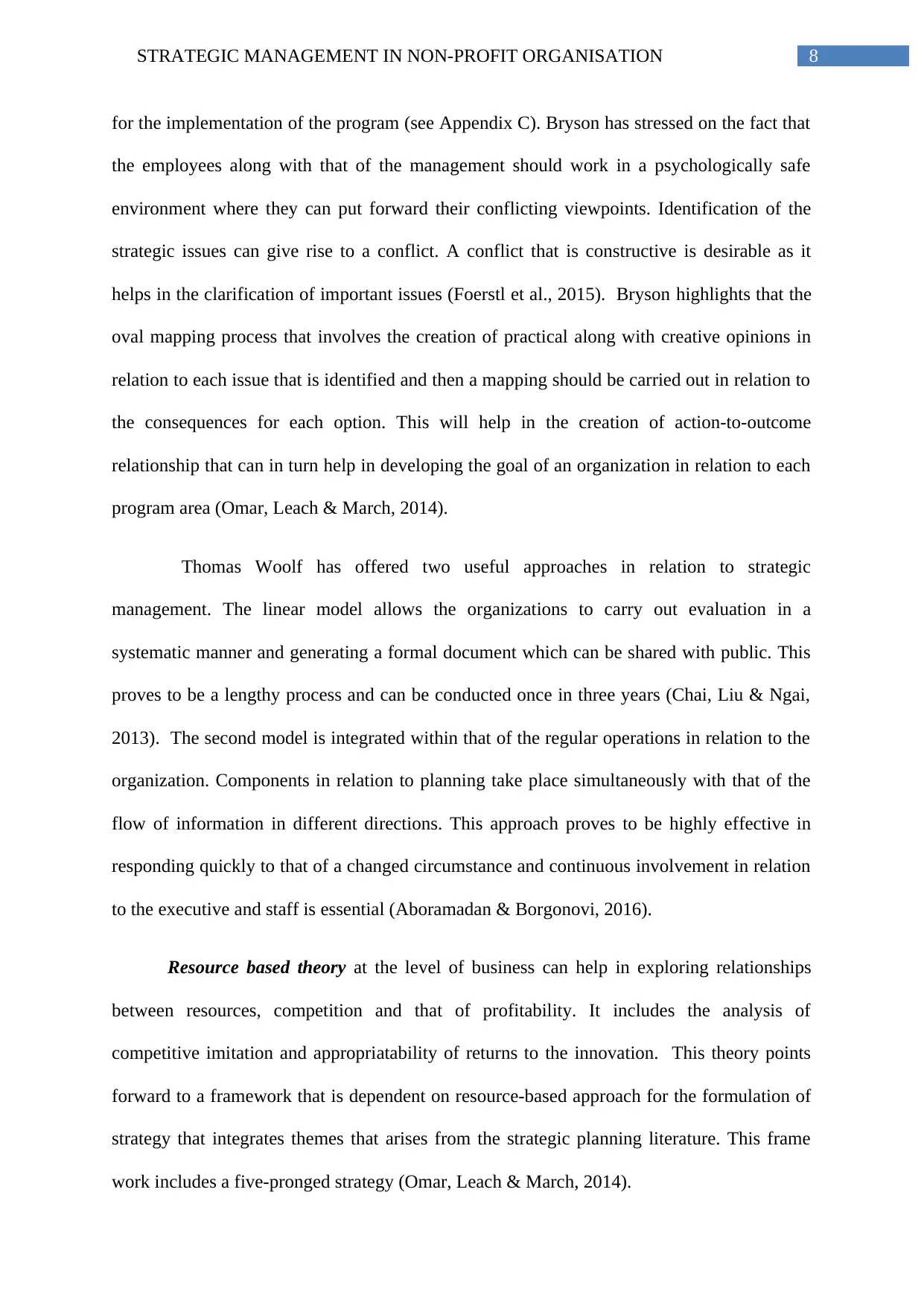
8STRATEGIC MANAGEMENT IN NON-PROFIT ORGANISATION
for the implementation of the program (see Appendix C). Bryson has stressed on the fact that
the employees along with that of the management should work in a psychologically safe
environment where they can put forward their conflicting viewpoints. Identification of the
strategic issues can give rise to a conflict. A conflict that is constructive is desirable as it
helps in the clarification of important issues (Foerstl et al., 2015). Bryson highlights that the
oval mapping process that involves the creation of practical along with creative opinions in
relation to each issue that is identified and then a mapping should be carried out in relation to
the consequences for each option. This will help in the creation of action-to-outcome
relationship that can in turn help in developing the goal of an organization in relation to each
program area (Omar, Leach & March, 2014).
Thomas Woolf has offered two useful approaches in relation to strategic
management. The linear model allows the organizations to carry out evaluation in a
systematic manner and generating a formal document which can be shared with public. This
proves to be a lengthy process and can be conducted once in three years (Chai, Liu & Ngai,
2013). The second model is integrated within that of the regular operations in relation to the
organization. Components in relation to planning take place simultaneously with that of the
flow of information in different directions. This approach proves to be highly effective in
responding quickly to that of a changed circumstance and continuous involvement in relation
to the executive and staff is essential (Aboramadan & Borgonovi, 2016).
Resource based theory at the level of business can help in exploring relationships
between resources, competition and that of profitability. It includes the analysis of
competitive imitation and appropriatability of returns to the innovation. This theory points
forward to a framework that is dependent on resource-based approach for the formulation of
strategy that integrates themes that arises from the strategic planning literature. This frame
work includes a five-pronged strategy (Omar, Leach & March, 2014).
for the implementation of the program (see Appendix C). Bryson has stressed on the fact that
the employees along with that of the management should work in a psychologically safe
environment where they can put forward their conflicting viewpoints. Identification of the
strategic issues can give rise to a conflict. A conflict that is constructive is desirable as it
helps in the clarification of important issues (Foerstl et al., 2015). Bryson highlights that the
oval mapping process that involves the creation of practical along with creative opinions in
relation to each issue that is identified and then a mapping should be carried out in relation to
the consequences for each option. This will help in the creation of action-to-outcome
relationship that can in turn help in developing the goal of an organization in relation to each
program area (Omar, Leach & March, 2014).
Thomas Woolf has offered two useful approaches in relation to strategic
management. The linear model allows the organizations to carry out evaluation in a
systematic manner and generating a formal document which can be shared with public. This
proves to be a lengthy process and can be conducted once in three years (Chai, Liu & Ngai,
2013). The second model is integrated within that of the regular operations in relation to the
organization. Components in relation to planning take place simultaneously with that of the
flow of information in different directions. This approach proves to be highly effective in
responding quickly to that of a changed circumstance and continuous involvement in relation
to the executive and staff is essential (Aboramadan & Borgonovi, 2016).
Resource based theory at the level of business can help in exploring relationships
between resources, competition and that of profitability. It includes the analysis of
competitive imitation and appropriatability of returns to the innovation. This theory points
forward to a framework that is dependent on resource-based approach for the formulation of
strategy that integrates themes that arises from the strategic planning literature. This frame
work includes a five-pronged strategy (Omar, Leach & March, 2014).
⊘ This is a preview!⊘
Do you want full access?
Subscribe today to unlock all pages.

Trusted by 1+ million students worldwide
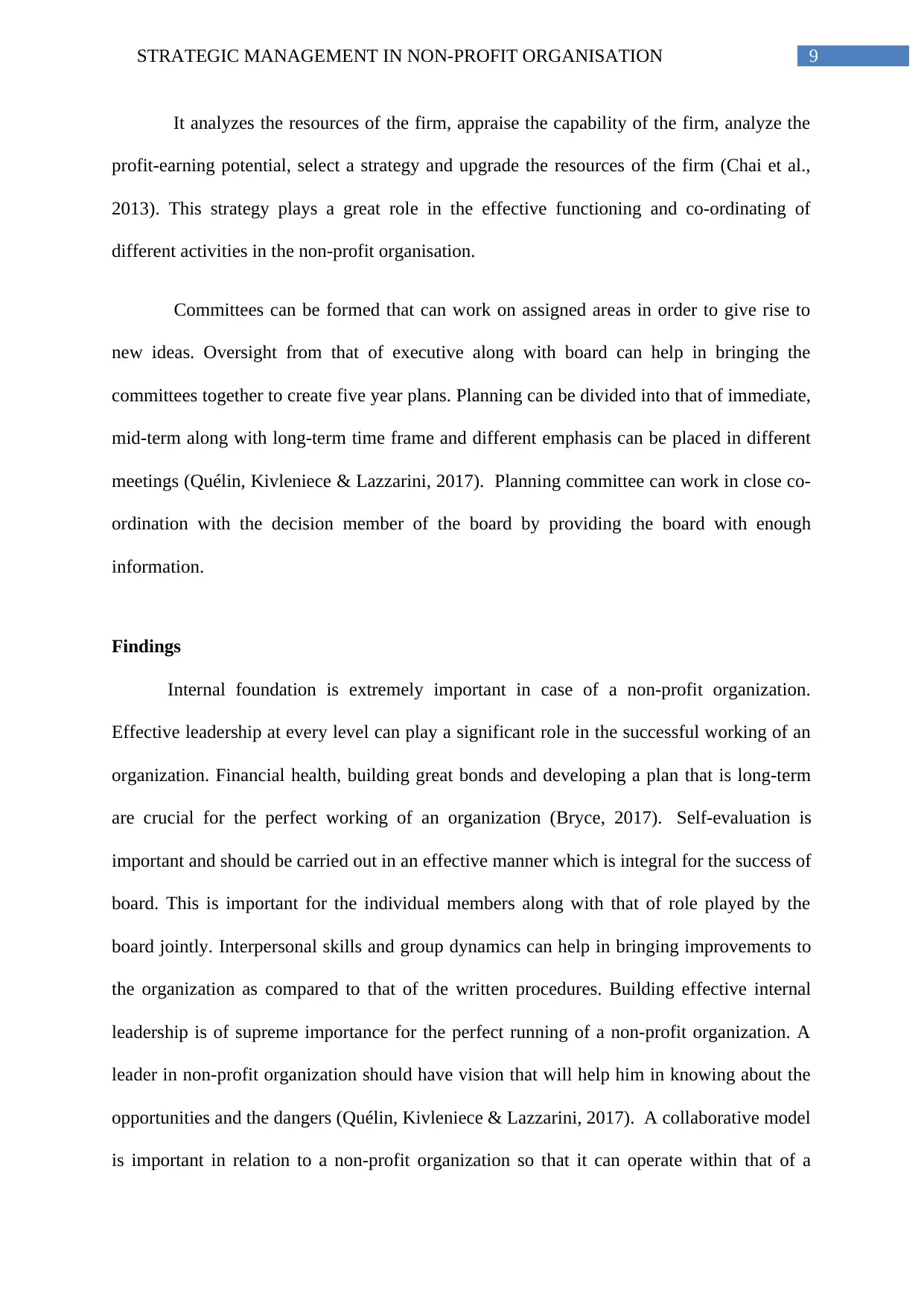
9STRATEGIC MANAGEMENT IN NON-PROFIT ORGANISATION
It analyzes the resources of the firm, appraise the capability of the firm, analyze the
profit-earning potential, select a strategy and upgrade the resources of the firm (Chai et al.,
2013). This strategy plays a great role in the effective functioning and co-ordinating of
different activities in the non-profit organisation.
Committees can be formed that can work on assigned areas in order to give rise to
new ideas. Oversight from that of executive along with board can help in bringing the
committees together to create five year plans. Planning can be divided into that of immediate,
mid-term along with long-term time frame and different emphasis can be placed in different
meetings (Quélin, Kivleniece & Lazzarini, 2017). Planning committee can work in close co-
ordination with the decision member of the board by providing the board with enough
information.
Findings
Internal foundation is extremely important in case of a non-profit organization.
Effective leadership at every level can play a significant role in the successful working of an
organization. Financial health, building great bonds and developing a plan that is long-term
are crucial for the perfect working of an organization (Bryce, 2017). Self-evaluation is
important and should be carried out in an effective manner which is integral for the success of
board. This is important for the individual members along with that of role played by the
board jointly. Interpersonal skills and group dynamics can help in bringing improvements to
the organization as compared to that of the written procedures. Building effective internal
leadership is of supreme importance for the perfect running of a non-profit organization. A
leader in non-profit organization should have vision that will help him in knowing about the
opportunities and the dangers (Quélin, Kivleniece & Lazzarini, 2017). A collaborative model
is important in relation to a non-profit organization so that it can operate within that of a
It analyzes the resources of the firm, appraise the capability of the firm, analyze the
profit-earning potential, select a strategy and upgrade the resources of the firm (Chai et al.,
2013). This strategy plays a great role in the effective functioning and co-ordinating of
different activities in the non-profit organisation.
Committees can be formed that can work on assigned areas in order to give rise to
new ideas. Oversight from that of executive along with board can help in bringing the
committees together to create five year plans. Planning can be divided into that of immediate,
mid-term along with long-term time frame and different emphasis can be placed in different
meetings (Quélin, Kivleniece & Lazzarini, 2017). Planning committee can work in close co-
ordination with the decision member of the board by providing the board with enough
information.
Findings
Internal foundation is extremely important in case of a non-profit organization.
Effective leadership at every level can play a significant role in the successful working of an
organization. Financial health, building great bonds and developing a plan that is long-term
are crucial for the perfect working of an organization (Bryce, 2017). Self-evaluation is
important and should be carried out in an effective manner which is integral for the success of
board. This is important for the individual members along with that of role played by the
board jointly. Interpersonal skills and group dynamics can help in bringing improvements to
the organization as compared to that of the written procedures. Building effective internal
leadership is of supreme importance for the perfect running of a non-profit organization. A
leader in non-profit organization should have vision that will help him in knowing about the
opportunities and the dangers (Quélin, Kivleniece & Lazzarini, 2017). A collaborative model
is important in relation to a non-profit organization so that it can operate within that of a
Paraphrase This Document
Need a fresh take? Get an instant paraphrase of this document with our AI Paraphraser
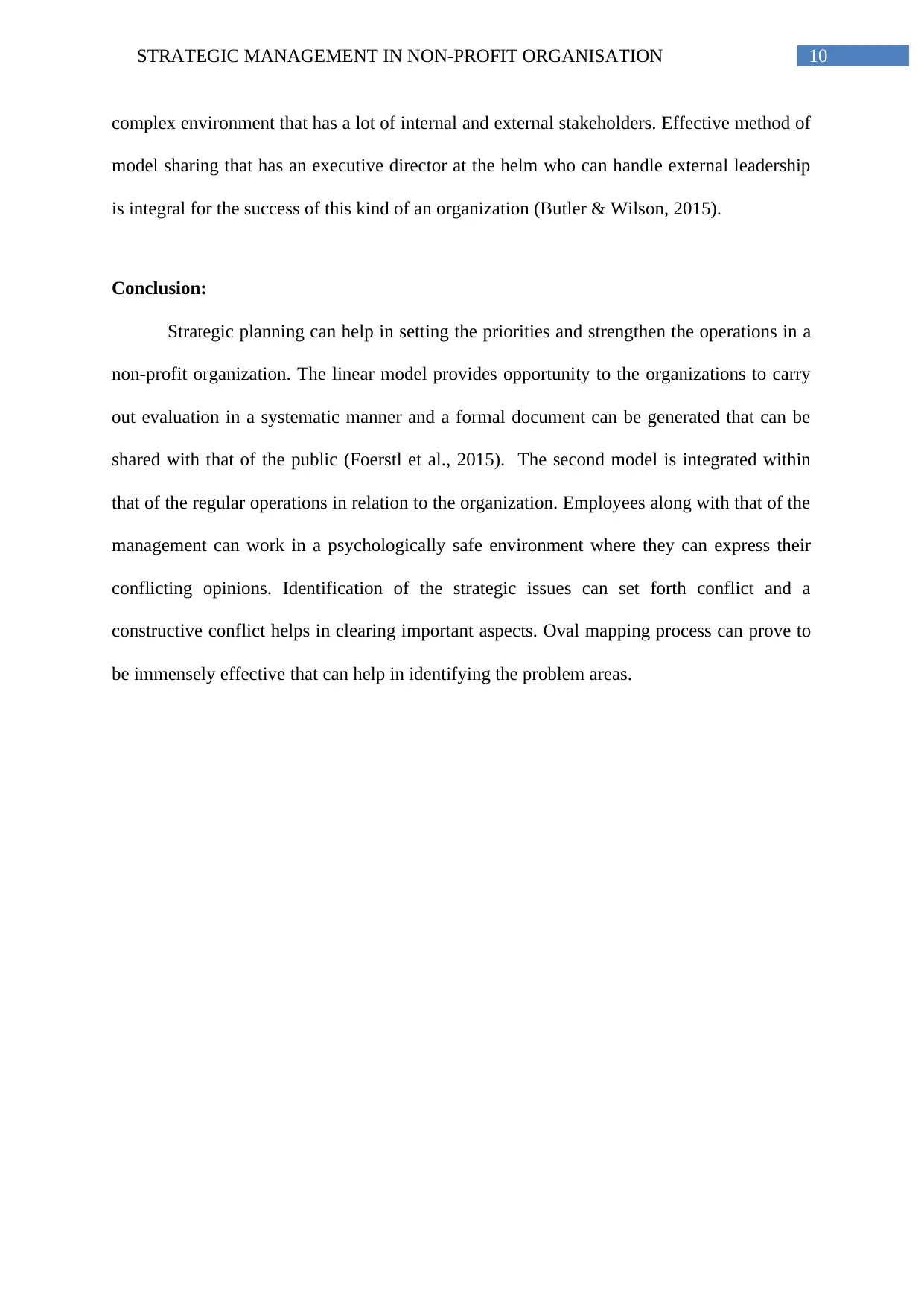
10STRATEGIC MANAGEMENT IN NON-PROFIT ORGANISATION
complex environment that has a lot of internal and external stakeholders. Effective method of
model sharing that has an executive director at the helm who can handle external leadership
is integral for the success of this kind of an organization (Butler & Wilson, 2015).
Conclusion:
Strategic planning can help in setting the priorities and strengthen the operations in a
non-profit organization. The linear model provides opportunity to the organizations to carry
out evaluation in a systematic manner and a formal document can be generated that can be
shared with that of the public (Foerstl et al., 2015). The second model is integrated within
that of the regular operations in relation to the organization. Employees along with that of the
management can work in a psychologically safe environment where they can express their
conflicting opinions. Identification of the strategic issues can set forth conflict and a
constructive conflict helps in clearing important aspects. Oval mapping process can prove to
be immensely effective that can help in identifying the problem areas.
complex environment that has a lot of internal and external stakeholders. Effective method of
model sharing that has an executive director at the helm who can handle external leadership
is integral for the success of this kind of an organization (Butler & Wilson, 2015).
Conclusion:
Strategic planning can help in setting the priorities and strengthen the operations in a
non-profit organization. The linear model provides opportunity to the organizations to carry
out evaluation in a systematic manner and a formal document can be generated that can be
shared with that of the public (Foerstl et al., 2015). The second model is integrated within
that of the regular operations in relation to the organization. Employees along with that of the
management can work in a psychologically safe environment where they can express their
conflicting opinions. Identification of the strategic issues can set forth conflict and a
constructive conflict helps in clearing important aspects. Oval mapping process can prove to
be immensely effective that can help in identifying the problem areas.
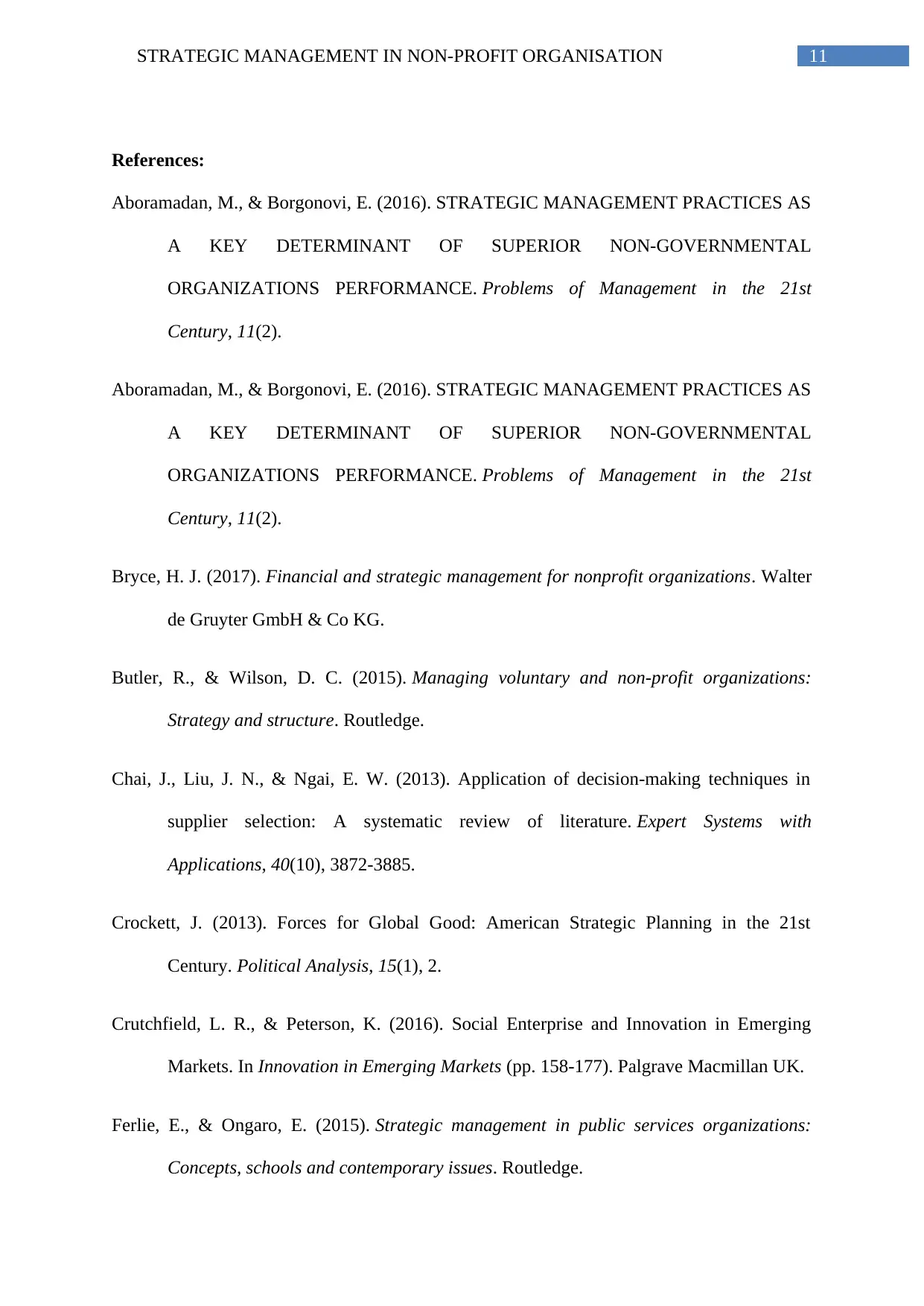
11STRATEGIC MANAGEMENT IN NON-PROFIT ORGANISATION
References:
Aboramadan, M., & Borgonovi, E. (2016). STRATEGIC MANAGEMENT PRACTICES AS
A KEY DETERMINANT OF SUPERIOR NON-GOVERNMENTAL
ORGANIZATIONS PERFORMANCE. Problems of Management in the 21st
Century, 11(2).
Aboramadan, M., & Borgonovi, E. (2016). STRATEGIC MANAGEMENT PRACTICES AS
A KEY DETERMINANT OF SUPERIOR NON-GOVERNMENTAL
ORGANIZATIONS PERFORMANCE. Problems of Management in the 21st
Century, 11(2).
Bryce, H. J. (2017). Financial and strategic management for nonprofit organizations. Walter
de Gruyter GmbH & Co KG.
Butler, R., & Wilson, D. C. (2015). Managing voluntary and non-profit organizations:
Strategy and structure. Routledge.
Chai, J., Liu, J. N., & Ngai, E. W. (2013). Application of decision-making techniques in
supplier selection: A systematic review of literature. Expert Systems with
Applications, 40(10), 3872-3885.
Crockett, J. (2013). Forces for Global Good: American Strategic Planning in the 21st
Century. Political Analysis, 15(1), 2.
Crutchfield, L. R., & Peterson, K. (2016). Social Enterprise and Innovation in Emerging
Markets. In Innovation in Emerging Markets (pp. 158-177). Palgrave Macmillan UK.
Ferlie, E., & Ongaro, E. (2015). Strategic management in public services organizations:
Concepts, schools and contemporary issues. Routledge.
References:
Aboramadan, M., & Borgonovi, E. (2016). STRATEGIC MANAGEMENT PRACTICES AS
A KEY DETERMINANT OF SUPERIOR NON-GOVERNMENTAL
ORGANIZATIONS PERFORMANCE. Problems of Management in the 21st
Century, 11(2).
Aboramadan, M., & Borgonovi, E. (2016). STRATEGIC MANAGEMENT PRACTICES AS
A KEY DETERMINANT OF SUPERIOR NON-GOVERNMENTAL
ORGANIZATIONS PERFORMANCE. Problems of Management in the 21st
Century, 11(2).
Bryce, H. J. (2017). Financial and strategic management for nonprofit organizations. Walter
de Gruyter GmbH & Co KG.
Butler, R., & Wilson, D. C. (2015). Managing voluntary and non-profit organizations:
Strategy and structure. Routledge.
Chai, J., Liu, J. N., & Ngai, E. W. (2013). Application of decision-making techniques in
supplier selection: A systematic review of literature. Expert Systems with
Applications, 40(10), 3872-3885.
Crockett, J. (2013). Forces for Global Good: American Strategic Planning in the 21st
Century. Political Analysis, 15(1), 2.
Crutchfield, L. R., & Peterson, K. (2016). Social Enterprise and Innovation in Emerging
Markets. In Innovation in Emerging Markets (pp. 158-177). Palgrave Macmillan UK.
Ferlie, E., & Ongaro, E. (2015). Strategic management in public services organizations:
Concepts, schools and contemporary issues. Routledge.
⊘ This is a preview!⊘
Do you want full access?
Subscribe today to unlock all pages.

Trusted by 1+ million students worldwide
1 out of 17
Related Documents
Your All-in-One AI-Powered Toolkit for Academic Success.
+13062052269
info@desklib.com
Available 24*7 on WhatsApp / Email
![[object Object]](/_next/static/media/star-bottom.7253800d.svg)
Unlock your academic potential
Copyright © 2020–2025 A2Z Services. All Rights Reserved. Developed and managed by ZUCOL.




